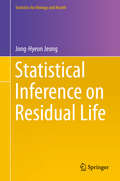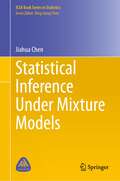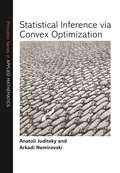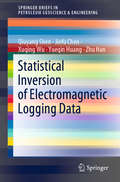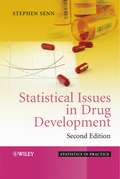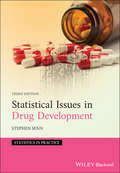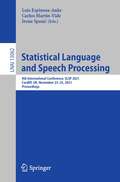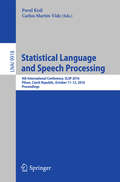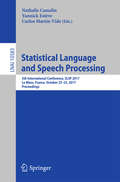- Table View
- List View
Statistical Inference for Fractional Diffusion Processes (Wiley Series in Probability and Statistics #870)
by B. L. RaoStochastic processes are widely used for model building in the social, physical, engineering and life sciences as well as in financial economics. In model building, statistical inference for stochastic processes is of great importance from both a theoretical and an applications point of view. This book deals with Fractional Diffusion Processes and statistical inference for such stochastic processes. The main focus of the book is to consider parametric and nonparametric inference problems for fractional diffusion processes when a complete path of the process over a finite interval is observable. Key features: Introduces self-similar processes, fractional Brownian motion and stochastic integration with respect to fractional Brownian motion. Provides a comprehensive review of statistical inference for processes driven by fractional Brownian motion for modelling long range dependence. Presents a study of parametric and nonparametric inference problems for the fractional diffusion process. Discusses the fractional Brownian sheet and infinite dimensional fractional Brownian motion. Includes recent results and developments in the area of statistical inference of fractional diffusion processes. Researchers and students working on the statistics of fractional diffusion processes and applied mathematicians and statisticians involved in stochastic process modelling will benefit from this book.
Statistical Inference for Models with Multivariate t-Distributed Errors
by A. K. Saleh Mohammad Arashi S M TabatabaeyThis book summarizes the results of various models under normal theory with a brief review of the literature. Statistical Inference for Models with Multivariate t-Distributed Errors: Includes a wide array of applications for the analysis of multivariate observations Emphasizes the development of linear statistical models with applications to engineering, the physical sciences, and mathematics Contains an up-to-date bibliography featuring the latest trends and advances in the field to provide a collective source for research on the topic Addresses linear regression models with non-normal errors with practical real-world examples Uniquely addresses regression models in Student's t-distributed errors and t-models Supplemented with an Instructor's Solutions Manual, which is available via written request by the Publisher
Statistical Inference for Models with Multivariate t-Distributed Errors
by A. K. Saleh Mohammad Arashi S M TabatabaeyThis book summarizes the results of various models under normal theory with a brief review of the literature. Statistical Inference for Models with Multivariate t-Distributed Errors: Includes a wide array of applications for the analysis of multivariate observations Emphasizes the development of linear statistical models with applications to engineering, the physical sciences, and mathematics Contains an up-to-date bibliography featuring the latest trends and advances in the field to provide a collective source for research on the topic Addresses linear regression models with non-normal errors with practical real-world examples Uniquely addresses regression models in Student's t-distributed errors and t-models Supplemented with an Instructor's Solutions Manual, which is available via written request by the Publisher
Statistical Inference for Piecewise-deterministic Markov Processes
by Romain Azaïs Florian BouguetPiecewise-deterministic Markov processes form a class of stochastic models with a sizeable scope of applications: biology, insurance, neuroscience, networks, finance... Such processes are defined by a deterministic motion punctuated by random jumps at random times, and offer simple yet challenging models to study. Nevertheless, the issue of statistical estimation of the parameters ruling the jump mechanism is far from trivial. Responding to new developments in the field as well as to current research interests and needs, Statistical inference for piecewise-deterministic Markov processes offers a detailed and comprehensive survey of state-of-the-art results. It covers a wide range of general processes as well as applied models. The present book also dwells on statistics in the context of Markov chains, since piecewise-deterministic Markov processes are characterized by an embedded Markov chain corresponding to the position of the process right after the jumps.
Statistical Inference for Piecewise-deterministic Markov Processes
by Romain Azais Florian BouguetPiecewise-deterministic Markov processes form a class of stochastic models with a sizeable scope of applications: biology, insurance, neuroscience, networks, finance... Such processes are defined by a deterministic motion punctuated by random jumps at random times, and offer simple yet challenging models to study. Nevertheless, the issue of statistical estimation of the parameters ruling the jump mechanism is far from trivial. Responding to new developments in the field as well as to current research interests and needs, Statistical inference for piecewise-deterministic Markov processes offers a detailed and comprehensive survey of state-of-the-art results. It covers a wide range of general processes as well as applied models. The present book also dwells on statistics in the context of Markov chains, since piecewise-deterministic Markov processes are characterized by an embedded Markov chain corresponding to the position of the process right after the jumps.
Statistical Inference for Spatial Poisson Processes (Lecture Notes in Statistics #134)
by Yu A. KutoyantsThis work is devoted to several problems of parametric (mainly) and nonparametric estimation through the observation of Poisson processes defined on general spaces. Poisson processes are quite popular in applied research and therefore they attract the attention of many statisticians. There are a lot of good books on point processes and many of them contain chapters devoted to statistical inference for general and partic ular models of processes. There are even chapters on statistical estimation problems for inhomogeneous Poisson processes in asymptotic statements. Nevertheless it seems that the asymptotic theory of estimation for nonlinear models of Poisson processes needs some development. Here nonlinear means the models of inhomogeneous Pois son processes with intensity function nonlinearly depending on unknown parameters. In such situations the estimators usually cannot be written in exact form and are given as solutions of some equations. However the models can be quite fruitful in en gineering problems and the existing computing algorithms are sufficiently powerful to calculate these estimators. Therefore the properties of estimators can be interesting too.
Statistical Inference in Financial and Insurance Mathematics with R
by Alexandre BrousteFinance and insurance companies are facing a wide range of parametric statistical problems. Statistical experiments generated by a sample of independent and identically distributed random variables are frequent and well understood, especially those consisting of probability measures of an exponential type. However, the aforementioned applications also offer non-classical experiments implying observation samples of independent but not identically distributed random variables or even dependent random variables. Three examples of such experiments are treated in this book. First, the Generalized Linear Models are studied. They extend the standard regression model to non-Gaussian distributions. Statistical experiments with Markov chains are considered next. Finally, various statistical experiments generated by fractional Gaussian noise are also described. In this book, asymptotic properties of several sequences of estimators are detailed. The notion of asymptotical efficiency is discussed for the different statistical experiments considered in order to give the proper sense of estimation risk. Eighty examples and computations with R software are given throughout the text.Examines a range of statistical inference methods in the context of finance and insurance applicationsPresents the LAN (local asymptotic normality) property of likelihoodsCombines the proofs of LAN property for different statistical experiments that appears in financial and insurance mathematicsProvides the proper description of such statistical experiments and invites readers to seek optimal estimators (performed in R) for such statistical experiments
Statistical Inference in Science (Springer Series in Statistics)
by D.A. SprottA treatment of the problems of inference associated with experiments in science, with the emphasis on techniques for dividing the sample information into various parts, such that the diverse problems of inference that arise from repeatable experiments may be addressed. A particularly valuable feature is the large number of practical examples, many of which use data taken from experiments published in various scientific journals. This book evolved from the authors own courses on statistical inference, and assumes an introductory course in probability, including the calculation and manipulation of probability functions and density functions, transformation of variables and the use of Jacobians. While this is a suitable text book for advanced undergraduate, Masters, and Ph.D. statistics students, it may also be used as a reference book.
Statistical Inference in Stochastic Processes
by N.U. Prabhu and I.V. BasawaCovering both theory and applications, this collection of eleven contributed papers surveys the role of probabilistic models and statistical techniques in image analysis and processing, develops likelihood methods for inference about parameters that determine the drift and the jump mechanism of a di
Statistical Inference in Stochastic Processes
Covering both theory and applications, this collection of eleven contributed papers surveys the role of probabilistic models and statistical techniques in image analysis and processing, develops likelihood methods for inference about parameters that determine the drift and the jump mechanism of a di
Statistical Inference on Residual Life (Statistics for Biology and Health)
by Jong-Hyeon JeongThis is a monograph on the concept of residual life, which is an alternative summary measure of time-to-event data, or survival data. The mean residual life has been used for many years under the name of life expectancy, so it is a natural concept for summarizing survival or reliability data. It is also more interpretable than the popular hazard function, especially for communications between patients and physicians regarding the efficacy of a new drug in the medical field. This book reviews existing statistical methods to infer the residual life distribution. The review and comparison includes existing inference methods for mean and median, or quantile, residual life analysis through medical data examples. The concept of the residual life is also extended to competing risks analysis. The targeted audience includes biostatisticians, graduate students, and PhD (bio)statisticians. Knowledge in survival analysis at an introductory graduate level is advisable prior to reading this book.
Statistical Inference Under Mixture Models (ICSA Book Series in Statistics)
by Jiahua ChenThis book puts its weight on theoretical issues related to finite mixture models. It shows that a good applicant, is an applicant who understands the issues behind each statistical method. This book is intended for applicants whose interests include some understanding of the procedures they are using, while they do not have to read the technical derivations.At the same time, many researchers find most theories and techniques necessary for the development of various statistical methods, without chasing after one set of research papers, after another. Even though the book emphasizes the theory, it provides accessible numerical tools for data analysis. Readers with strength in developing statistical software, may find it useful.
Statistical Inference via Convex Optimization (PDF)
by Anatoli Juditsky Arkadi NemirovskiThis authoritative book draws on the latest research to explore the interplay of high-dimensional statistics with optimization. Through an accessible analysis of fundamental problems of hypothesis testing and signal recovery, Anatoli Juditsky and Arkadi Nemirovski show how convex optimization theory can be used to devise and analyze near-optimal statistical inferences.Statistical Inference via Convex Optimization is an essential resource for optimization specialists who are new to statistics and its applications, and for data scientists who want to improve their optimization methods. Juditsky and Nemirovski provide the first systematic treatment of the statistical techniques that have arisen from advances in the theory of optimization. They focus on four well-known statistical problems—sparse recovery, hypothesis testing, and recovery from indirect observations of both signals and functions of signals—demonstrating how they can be solved more efficiently as convex optimization problems. The emphasis throughout is on achieving the best possible statistical performance. The construction of inference routines and the quantification of their statistical performance are given by efficient computation rather than by analytical derivation typical of more conventional statistical approaches. In addition to being computation-friendly, the methods described in this book enable practitioners to handle numerous situations too difficult for closed analytical form analysis, such as composite hypothesis testing and signal recovery in inverse problems.Statistical Inference via Convex Optimization features exercises with solutions along with extensive appendixes, making it ideal for use as a graduate text.
Statistical Inference via Data Science: A ModernDive into R and the Tidyverse (Chapman & Hall/CRC The R Series)
by Chester Ismay Albert Y. KimStatistical Inference via Data Science: A ModernDive into R and the Tidyverse provides a pathway for learning about statistical inference using data science tools widely used in industry, academia, and government. It introduces the tidyverse suite of R packages, including the ggplot2 package for data visualization, and the dplyr package for data wrangling. After equipping readers with just enough of these data science tools to perform effective exploratory data analyses, the book covers traditional introductory statistics topics like confidence intervals, hypothesis testing, and multiple regression modeling, while focusing on visualization throughout. Features: ● Assumes minimal prerequisites, notably, no prior calculus nor coding experience ● Motivates theory using real-world data, including all domestic flights leaving New York City in 2013, the Gapminder project, and the data journalism website, FiveThirtyEight.com ● Centers on simulation-based approaches to statistical inference rather than mathematical formulas ● Uses the infer package for "tidy" and transparent statistical inference to construct confidence intervals and conduct hypothesis tests via the bootstrap and permutation methods ● Provides all code and output embedded directly in the text; also available in the online version at moderndive.com This book is intended for individuals who would like to simultaneously start developing their data science toolbox and start learning about the inferential and modeling tools used in much of modern-day research. The book can be used in methods and data science courses and first courses in statistics, at both the undergraduate and graduate levels.
Statistical Inference via Data Science: A ModernDive into R and the Tidyverse (Chapman & Hall/CRC The R Series)
by Chester Ismay Albert Y. KimStatistical Inference via Data Science: A ModernDive into R and the Tidyverse provides a pathway for learning about statistical inference using data science tools widely used in industry, academia, and government. It introduces the tidyverse suite of R packages, including the ggplot2 package for data visualization, and the dplyr package for data wrangling. After equipping readers with just enough of these data science tools to perform effective exploratory data analyses, the book covers traditional introductory statistics topics like confidence intervals, hypothesis testing, and multiple regression modeling, while focusing on visualization throughout. Features: ● Assumes minimal prerequisites, notably, no prior calculus nor coding experience ● Motivates theory using real-world data, including all domestic flights leaving New York City in 2013, the Gapminder project, and the data journalism website, FiveThirtyEight.com ● Centers on simulation-based approaches to statistical inference rather than mathematical formulas ● Uses the infer package for "tidy" and transparent statistical inference to construct confidence intervals and conduct hypothesis tests via the bootstrap and permutation methods ● Provides all code and output embedded directly in the text; also available in the online version at moderndive.com This book is intended for individuals who would like to simultaneously start developing their data science toolbox and start learning about the inferential and modeling tools used in much of modern-day research. The book can be used in methods and data science courses and first courses in statistics, at both the undergraduate and graduate levels.
Statistical Information and Likelihood: A Collection of Critical Essays by Dr. D. Basu (Lecture Notes in Statistics #45)
by D. BasuIt is an honor to be asked to write a foreword to this book, for I believe that it and other books to follow will eventually lead to a dramatic change in the current statistics curriculum in our universities. I spent the 1975-76 academic year at Florida State University in Tallahassee. My purpose was to complete a book on Statistical Reliability Theory with Frank Proschan. At the time, I was working on total time on test processes. At the same time, I started attending lectures by Dev Basu on statistical inference. It was Lehmann's hypothesis testing course and Lehmann's book was the text. However, I noticed something strange - Basu never opened the book. He was obviously not following it. Instead, he was giving a very elegant, measure theoretic treatment of the concepts of sufficiency, ancillarity, and invariance. He was interested in the concept of information - what it meant. - how it fitted in with contemporary statistics. As he looked at the fundamental ideas, the logic behind their use seemed to evaporate. I was shocked. I didn't like priors. I didn't like Bayesian statistics. But after the smoke had cleared, that was all that was left. Basu loves counterexamples. He is like an art critic in the field of statistical inference. He would find a counterexample to the Bayesian approach if he could. So far, he has failed in this respect.
Statistical Intervals: A Guide for Practitioners and Researchers (Wiley Series in Probability and Statistics #541)
by William Q. Meeker Gerald J. Hahn Luis A. EscobarDescribes statistical intervals to quantify sampling uncertainty,focusing on key application needs and recently developed methodology in an easy-to-apply format Statistical intervals provide invaluable tools for quantifying sampling uncertainty. The widely hailed first edition, published in 1991, described the use and construction of the most important statistical intervals. Particular emphasis was given to intervals—such as prediction intervals, tolerance intervals and confidence intervals on distribution quantiles—frequently needed in practice, but often neglected in introductory courses. Vastly improved computer capabilities over the past 25 years have resulted in an explosion of the tools readily available to analysts. This second edition—more than double the size of the first—adds these new methods in an easy-to-apply format. In addition to extensive updating of the original chapters, the second edition includes new chapters on: Likelihood-based statistical intervals Nonparametric bootstrap intervals Parametric bootstrap and other simulation-based intervals An introduction to Bayesian intervals Bayesian intervals for the popular binomial, Poisson and normal distributions Statistical intervals for Bayesian hierarchical models Advanced case studies, further illustrating the use of the newly described methods New technical appendices provide justification of the methods and pathways to extensions and further applications. A webpage directs readers to current readily accessible computer software and other useful information. Statistical Intervals: A Guide for Practitioners and Researchers, Second Edition is an up-to-date working guide and reference for all who analyze data, allowing them to quantify the uncertainty in their results using statistical intervals.
Statistical Intervals: A Guide for Practitioners and Researchers (Wiley Series in Probability and Statistics #541)
by William Q. Meeker Gerald J. Hahn Luis A. EscobarDescribes statistical intervals to quantify sampling uncertainty,focusing on key application needs and recently developed methodology in an easy-to-apply format Statistical intervals provide invaluable tools for quantifying sampling uncertainty. The widely hailed first edition, published in 1991, described the use and construction of the most important statistical intervals. Particular emphasis was given to intervals—such as prediction intervals, tolerance intervals and confidence intervals on distribution quantiles—frequently needed in practice, but often neglected in introductory courses. Vastly improved computer capabilities over the past 25 years have resulted in an explosion of the tools readily available to analysts. This second edition—more than double the size of the first—adds these new methods in an easy-to-apply format. In addition to extensive updating of the original chapters, the second edition includes new chapters on: Likelihood-based statistical intervals Nonparametric bootstrap intervals Parametric bootstrap and other simulation-based intervals An introduction to Bayesian intervals Bayesian intervals for the popular binomial, Poisson and normal distributions Statistical intervals for Bayesian hierarchical models Advanced case studies, further illustrating the use of the newly described methods New technical appendices provide justification of the methods and pathways to extensions and further applications. A webpage directs readers to current readily accessible computer software and other useful information. Statistical Intervals: A Guide for Practitioners and Researchers, Second Edition is an up-to-date working guide and reference for all who analyze data, allowing them to quantify the uncertainty in their results using statistical intervals.
Statistical Inversion of Electromagnetic Logging Data (SpringerBriefs in Petroleum Geoscience & Engineering)
by Qiuyang Shen Jiefu Chen Xuqing Wu Yueqin Huang Zhu HanThis book presents a comprehensive introduction to well logging and the inverse problem. It explores challenges such as conventional data processing methods’ inability to handle local minima issues, and presents the explanations in an easy-to-follow way. The book describes statistical data interpretation by introducing the fundamentals behind the approach, as well as a range of sampling methods. In each chapter, a specific method is comprehensively introduced, together with representative examples. The book begins with basic information on well logging and logging while drilling, as well as a definition of the inverse problem. It then moves on to discuss the fundamentals of statistical inverse methods, Bayesian inference, and a new sampling method that can be used to supplement it, the hybrid Monte Carlo method. The book then addresses a specific problem in the inversion of downhole logging data, and the interpretation of earth model complexity, before concluding with a meta-technique called the tempering method, which serves as a supplement to statistical sampling methods. Given its scope, the book offers a valuable reference guide for drilling engineers, well logging tool physicists, and geoscientists, as well as students in the areas of petroleum engineering and electrical engineering.
Statistical Issues in Drug Development (Statistics in Practice #69)
by Stephen S. SennDrug development is the process of finding and producing therapeutically useful pharmaceuticals, turning them into safe and effective medicine, and producing reliable information regarding the appropriate dosage and dosing intervals. With regulatory authorities demanding increasingly higher standards in such developments, statistics has become an intrinsic and critical element in the design and conduct of drug development programmes. Statistical Issues in Drug Development presents an essential and thought provoking guide to the statistical issues and controversies involved in drug development. This highly readable second edition has been updated to include: Comprehensive coverage of the design and interpretation of clinical trials. Expanded sections on missing data, equivalence, meta-analysis and dose finding. An examination of both Bayesian and frequentist methods. A new chapter on pharmacogenomics and expanded coverage of pharmaco-epidemiology and pharmaco-economics. Coverage of the ICH guidelines, in particular ICH E9, Statistical Principles for Clinical Trials. It is hoped that the book will stimulate dialogue between statisticians and life scientists working within the pharmaceutical industry. The accessible and wide-ranging coverage make it essential reading for both statisticians and non-statisticians working in the pharmaceutical industry, regulatory bodies and medical research institutes. There is also much to benefit undergraduate and postgraduate students whose courses include a medical statistics component.
Statistical Issues in Drug Development (Statistics in Practice)
by Stephen S. SennStatistical Issues in Drug Development The revised third edition of Statistical Issues in Drug Development delivers an insightful treatment of the intersection between statistics and the life sciences. The book offers readers new discussions of crucial topics, including cluster randomization, historical controls, responder analysis, studies in children, post-hoc tests, estimands, publication bias, the replication crisis, and many more.This work presents the major statistical issues in drug development in a way that is accessible and comprehensible to life scientists working in the field, and takes pains not to gloss over significant disagreements in the field of statistics, while encouraging communication between the statistical and life sciences disciplines. In addition to new material on topics like invalid inversion, severity, random effects in network meta-analysis, and explained variation, readers will benefit from the inclusion of:A thorough introduction to basic topics in drug development and statistics, including the role played by statistics in drug developmentAn exploration of the four views of statistics in drug development, including the historical, methodological, technical, and professionalAn examination of debatable and controversial topics in drug development, including the allocation of treatments to patients in clinical trials, baselines and covariate information, and the measurement of treatment effectsPerfect for life scientists and other professionals working in the field of drug development, Statistical Issues in Drug Development is the ideal resource for anyone seeking a one-stop reference to enhance their understanding of the use of statistics during drug development.
Statistical Issues in Drug Development (Statistics in Practice)
by Stephen S. SennStatistical Issues in Drug Development The revised third edition of Statistical Issues in Drug Development delivers an insightful treatment of the intersection between statistics and the life sciences. The book offers readers new discussions of crucial topics, including cluster randomization, historical controls, responder analysis, studies in children, post-hoc tests, estimands, publication bias, the replication crisis, and many more.This work presents the major statistical issues in drug development in a way that is accessible and comprehensible to life scientists working in the field, and takes pains not to gloss over significant disagreements in the field of statistics, while encouraging communication between the statistical and life sciences disciplines. In addition to new material on topics like invalid inversion, severity, random effects in network meta-analysis, and explained variation, readers will benefit from the inclusion of:A thorough introduction to basic topics in drug development and statistics, including the role played by statistics in drug developmentAn exploration of the four views of statistics in drug development, including the historical, methodological, technical, and professionalAn examination of debatable and controversial topics in drug development, including the allocation of treatments to patients in clinical trials, baselines and covariate information, and the measurement of treatment effectsPerfect for life scientists and other professionals working in the field of drug development, Statistical Issues in Drug Development is the ideal resource for anyone seeking a one-stop reference to enhance their understanding of the use of statistics during drug development.
Statistical Language and Speech Processing: 9th International Conference, SLSP 2021, Virtual Event, November 22-26, 2021, Proceedings (Lecture Notes in Computer Science #13062)
by Luis Espinosa-Anke Carlos Martín-Vide Irena SpasićThis book constitutes the proceedings of the 9th International Conference on Statistical Language and Speech Processing, SLSP 2021, held in Cardiff, UK, in November 2021.The 9 full papers presented in this volume were carefully reviewed and selected from 21 submissions. The papers present topics of either theoretical or applied interest discussing the employment of statistical models (including machine learning) within language and speech processing.
Statistical Language and Speech Processing: 4th International Conference, SLSP 2016, Pilsen, Czech Republic, October 11-12, 2016, Proceedings (Lecture Notes in Computer Science #9918)
by Pavel Král Carlos Martín-VideThis book constitutes the refereed proceedings of the 4th International Conference on Statistical Language and Speech Processing, SLSP 2016, held in Pilsen, Czech Republic, in October 2016. The 11 full papers presented together with two invited talks were carefully reviewed and selected from 38 submissions. The papers cover topics such as anaphora and coreference resolution; authorship identification, plagiarism and spam filtering; computer-aided translation; corpora and language resources; data mining and semantic web; information extraction; information retrieval; knowledge representation and ontologies; lexicons and dictionaries; machine translation; multimodal technologies; natural language understanding; neural representation of speech and language; opinion mining and sentiment analysis; parsing; part-of-speech tagging; question and answering systems; semantic role labeling; speaker identification and verification; speech and language generation; speech recognition; speech synthesis; speech transcription; speech correction; spoken dialogue systems; term extraction; text categorization; test summarization; user modeling.
Statistical Language and Speech Processing: 5th International Conference, SLSP 2017, Le Mans, France, October 23–25, 2017, Proceedings (Lecture Notes in Computer Science #10583)
by Nathalie Camelin, Yannick Estève and Carlos Martín-VideThis book constitutes the refereed proceedings of the 5th International Conference on Statistical Language and Speech Processing, SLSP 2017, held in Le Mans, France, in October 2017. The 21 full papers presented were carefully reviewed and selected from 39 submissions. The papers cover topics such as anaphora and conference resolution; authorship identification, plagiarism and spam filtering; computer-aided translation; corpora and language resources; data mining and semanticweb; information extraction; information retrieval; knowledge representation and ontologies; lexicons and dictionaries; machine translation; multimodal technologies; natural language understanding; neural representation of speech and language; opinion mining and sentiment analysis; parsing; part-of-speech tagging; question and answering systems; semantic role labeling; speaker identification and verification; speech and language generation; speech recognition; speech synthesis; speech transcription; speech correction; spoken dialogue systems; term extraction; text categorization; test summarization; user modeling. They are organized in the following sections: language and information extraction; post-processing and applications of automatic transcriptions; speech paralinguistics and synthesis; speech recognition: modeling and resources.







